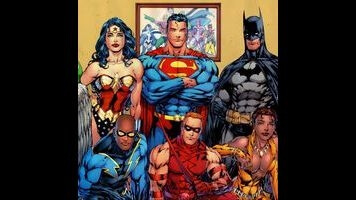Justice League: “Injustice For All”

“Injustice For All” (season 1, episodes 8-9; originally aired 9/6/2002 and 9/13/2002)
After a string of enjoyable but conventional mini-movie episodes, Justice League has it’s first superhero vs. supervillain brawl, as Lex Luthor assembles the Injustice Gang to take down the League. “Injustice For All” is a landmark episode in the series, establishing the diverse range of characters Timm and company plan to use while placing a heavier emphasis on humor than its predecessors. It’s a glimpse at what the series will evolve into and one of the highlights of the first season, especially with the reunion of Kevin Conroy’s Batman and Mark Hamill’s Joker.
“Injustice For All” is the series’ first all-fun episode, and writer Stan Berkowitz keeps a light-hearted tone throughout, even with the whole “Lex Luthor is dying” storyline. There’s the silliness of Superfriends (hey look, Wonder Twins statues!), but the character storytelling is more evolved, giving the villains unique personalities and motivations, and presenting more complex conflicts for the heroes. The assortment of villains for the Injustice Gang includes fan favorites like the Shade and Solomon Grundy (thanks, Starman), and Ultra-Humanite and Cheetah are used to great comic effect.
When Lex Luthor learns that he’s dying from Kryptonite blood poisoning, he abandons any illusions of being a legitimate businessman and gives himself over to total villainy. Under the promise of an ever-increasing payday, Luthor gathers Ultra-Humanite, Solomon Grundy, Star Sapphire, Cheetah, Copperhead, and the Shade, a group of conflicting personalities that only gets more unstable when Joker shows up uninvited. Villain teams are fundamentally flawed because every member is in it for himself (count how many times one of the Injustice Gang mentions getting paid). When faced with a more appealing offer, a villain has no problem betraying the group in the name of self-preservation, and that treachery inevitably leads to Luthor’s downfall.
Lex Luthor will be a constant presence throughout Justice League, and Clancy Brown returns to give Luthor that smooth, low voice that is both charming and scary. Lex may be Superman’s greatest villain, but he’s a stronger foil for Batman, as they are both ordinary men with a fierce sense of pride and duty. Bruce Wayne had tragedy to ground him, but Lex was spoiled his entire life, and while Bruce focuses his intellect on stopping the dregs of society, Lex picks a fight with a benevolent deity. Lex refuses to believe that his circumstances arise from the consequences of his own actions, and he blames Superman for everything, including his terminal illness.
Joker doesn’t really blame anyone for anything, he just likes hitting people with bags full of rocks. Mark Hamill returns to voice the Clown Prince of Crime, and his signature blend of charming comedian and terrifying psychopath helps maintain Berkowitz’s playful tone. Hamill and Conroy have developed great chemistry over the years, and they have both become so synonymous with the DCAU that their scenes together have an almost epic feel. The Bat-embargo prevented Joker from being used in Justice League Unlimited, and these are some of the last scenes Conroy and Hamill have together (until the Arkham games, that is).
The entire Justice League appears this episode for the first time since the pilot, but “Injustice For All” is all about Batman. After being poisoned by a bite from Copperhead, Batman stumbles out of his watchtower hospital bed to continue investigating the Injustice Gang. J’onn thinks Batman is trying protect his pride, telling him that he doesn’t have to prove himself just because he’s the only member without powers, but it’s all part of Batman’s plan. Batman may not have superpowers, but he’s a genius, and when he’s taken hostage by Luthor’s crew, he manipulates the Injustice Gang into a state of chaos. He has Grundy and Humanite wrestle each other over wage discrepancies, and seduces Cheetah in one of Kevin Conroy’s best comedic moments. It’s so good, I’m just going to post the whole scene:
That whispered “Try me,” might be my favorite Batman moment on this series, if it wasn’t for his jazz solo in “This Little Piggy.” Batman could escape his shackles at any time, but he chooses to stay to gather information. The intel ends up saving the watchtower after the Injustice Gang plants a bomb on it, even if the villains got up there using Batman’s space garage opener.
The episode’s final gag reveals that Ultra-Humanite betrays the Injustice Gang so he could donate the exorbitant amount of money Batman offered him to public broadcasting. Ultra-Humanite has it made in prison, while he’s a talking big-headed monkey when he’s out on the streets. I like to think that Humanite’s plan all along was to collect the money from Lex and then just go back to prison, where he could enjoy a performance of Madama Butterfly from the comfort of his cell.
Stray observations
- Injustice Gang. Really?
- Star Sapphire is oddly British, but according to Bruce Timm, still Carol Ferris. I’ll just assume Star Sapphire is a separate personality from Carol, and for some reason British. It makes her seem even crazier!
- New issue of Shade’s miniseries is out this week. It’s the good James Robinson!
- Anyone else remember the Warner Bros. Studio store?
- This is the first time Green Lantern uses his ring as a blacklight, tracing an energy signal to the bomb hidden on the watchtower. It will not be the last.
- Flash: “Fastest man alive.” Hawkgirl: “Which might explain why you can’t get a date.”
- Hamill is at his creepiest when he’s trying to convince Lex to kill Batman, whispering, “Don’t wait. Do it now.”
- “Et tu, Humanite?”
- “You’re dethspicable!”
- This episode has one of Hamill’s most ridiculous Joker laughs, heard below at 3:04.